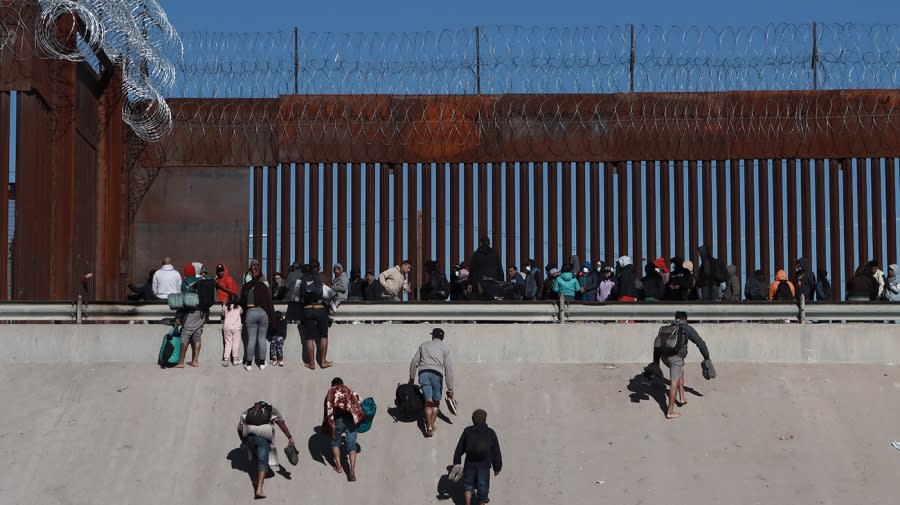Biden administration seeks new path as end of Title 42 looms

The Biden administration is looking to shift the focus on migration from a border issue to a hemispheric one ahead of the end of pandemic-related border control measures.
Administration officials have been preparing for the end of Title 42 for more than a year, fretting in public and private about how the policy’s end will affect border crossing numbers.
“Just like all extraordinary pandemic era measures, Title 42 is coming to an end because the national public health emergency is ending, in large part due to the efforts of this administration to provide Americans with the tools to protect themselves from COVID-19,” an administration official told reporters Thursday.
“The end of Title 42 does not mean, however, that the border is open.”
Under Title 42, U.S. border officials have been able to quickly expel migrants encountered at the border without processing them for asylum. Immigrant advocates have largely decried the policy as a violation of asylum law.
To replace the policy after its sunset, U.S. authorities are expected to rely heavily on expedited removal under Title 8, the regular border processing statute, though they worry news of the end of Title 42 could prompt more migrants to attempt to enter the United States by land.
As part of the administration’s new policy, officials are warning that migrants who are encountered and processed under expedited removal will be subject to a minimum five year bar on reentry to the United States under any circumstances and will be presumed ineligible for asylum in most cases.
Under Title 42, migrants who were summarily expelled faced no long-term U.S. immigration consequences and many attempted multiple unauthorized border crossings.
“Unlike Title 42, in which migrants who were expelled could keep trying to come back to the country with no consequences, [Title 8] carries additional stiffer consequences for unlawful migration, which include at least a five year ban on reentry as well as potential criminal prosecutions for repeated attempts to cross unlawfully,” an administration official said.
While the Biden administration is sending a message of heightened consequences for unauthorized border crossings, it is also attempting to dissuade overland arrivals by offshoring migrant processing.
Officials on Thursday announced a plan to create regional processing centers throughout the Western Hemisphere, starting with centers in Colombia and Guatemala, to help migrants determine whether they are eligible to enter the United States.
By processing migrants at these centers, officials hope to cut traffic on the northbound migrant path, while allowing more people to benefit from existing legal pathways to enter the United States.
“U.S. criteria for refugee resettlement will not change. However, through this expanded effort, we expect to identify more eligible individuals,” an administration official said.
In addition to screening for viable refugee claims, the processing centers will also determine whether migrants are eligible for other avenues of entry, like work visas, officials said.
Additionally, the plan calls for continued access for Haitians, Venezuelans, Nicaraguans and Cubans to a parole program that allows for 30,000 citizens of those countries to apply for entry to the United States.
Like the parole program, the processing centers will use the U.S. Customs and Border Protection CBP One app to set appointments to determine eligibility.
According to administration officials, the processing centers will also be able to place migrants in the Spanish and Canadian refugee and immigration systems, further expanding their reach.
“The measures that we are implementing today are really modeled on what we view as the success of the Cuba, Haiti, Nicaragua, Venezuela processes that show that the application of a significant consequence at the border with the significant expansion of lawful pathways can significantly reduce irregular migration alter migratory patterns, not just to the U.S. but throughout the region,” an official said.
The new strategy will also include a crackdown on migrant smugglers, with special attention to the Darien Gap, a bottleneck between Colombia and Panama that until recently was viewed as impassable jungle, but now hosts footpaths carved by thousands of migrants.
Still, Biden administration officials recognized many of the measures could be attacked in court, and they are operating with limited statutory authority.
“I would note, however, that we are fully cognizant that many of these measures are vulnerable to litigation. We are confident that we are operating within our statutory authority, but there is no lasting solution here that does not involve Congress, updating our hopelessly outdated immigration laws,” an official said.
For the latest news, weather, sports, and streaming video, head to The Hill.

